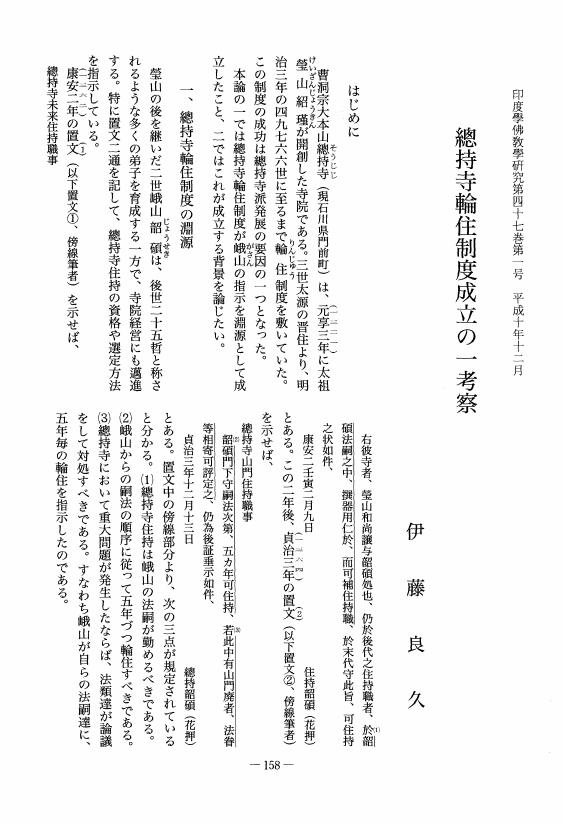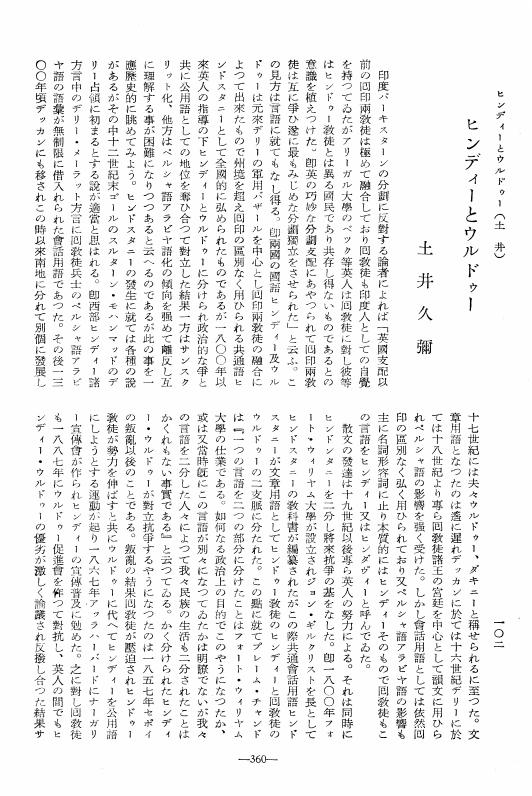1 0 0 0 OA 真宗における神祇不拝の教学史的変遷
- 著者
- 野世 英水
- 出版者
- Japanese Association of Indian and Buddhist Studies
- 雑誌
- 印度學佛教學研究 (ISSN:00194344)
- 巻号頁・発行日
- vol.39, no.1, pp.203-206, 1990-12-20 (Released:2010-03-09)
1 0 0 0 OA 總持寺輪住制度成立の一考察
- 著者
- 伊藤 良久
- 出版者
- Japanese Association of Indian and Buddhist Studies
- 雑誌
- 印度學佛教學研究 (ISSN:00194344)
- 巻号頁・発行日
- vol.47, no.1, pp.158-160, 1998-12-20 (Released:2010-03-09)
1 0 0 0 OA 中論における無自性と無 -青目釋「空亦復空」について-
- 著者
- 八力 廣喜
- 出版者
- Japanese Association of Indian and Buddhist Studies
- 雑誌
- 印度學佛教學研究 (ISSN:00194344)
- 巻号頁・発行日
- vol.17, no.2, pp.718-723, 1969-03-31 (Released:2010-03-09)
1 0 0 0 OA 廬山の禅宗
- 著者
- 鈴木 哲雄
- 出版者
- Japanese Association of Indian and Buddhist Studies
- 雑誌
- 印度學佛教學研究 (ISSN:00194344)
- 巻号頁・発行日
- vol.27, no.1, pp.276-279, 1978-12-31 (Released:2010-03-09)
1 0 0 0 OA 『不空羂索神変真言経』の梵本について
- 著者
- 高橋 尚夫
- 出版者
- Japanese Association of Indian and Buddhist Studies
- 雑誌
- 印度學佛教學研究 (ISSN:00194344)
- 巻号頁・発行日
- vol.40, no.2, pp.891-888, 1992-03-20 (Released:2010-03-09)
1 0 0 0 OA 竜樹の根本錯視としてのテーゼ「空性とは縁起のことである」
- 著者
- 津田 眞一
- 出版者
- Japanese Association of Indian and Buddhist Studies
- 雑誌
- 印度學佛教學研究 (ISSN:00194344)
- 巻号頁・発行日
- vol.50, no.1, pp.385-379, 2001-12-20 (Released:2010-03-09)
1 0 0 0 OA インドにおけるペルシア文学
- 著者
- 黒柳 恒男
- 出版者
- Japanese Association of Indian and Buddhist Studies
- 雑誌
- 印度學佛教學研究 (ISSN:00194344)
- 巻号頁・発行日
- vol.19, no.1, pp.108-111, 1970-12-25 (Released:2010-03-09)
1 0 0 0 OA ヒンディーとウルドゥー
- 著者
- 土井 久彌
- 出版者
- Japanese Association of Indian and Buddhist Studies
- 雑誌
- 印度學佛教學研究 (ISSN:00194344)
- 巻号頁・発行日
- vol.1, no.2, pp.360-361, 1953-03-25 (Released:2010-03-12)
1 0 0 0 OA 仏法と王法 -親鸞の君王加観-
- 著者
- 池田 勇諦
- 出版者
- Japanese Association of Indian and Buddhist Studies
- 雑誌
- 印度學佛教學研究 (ISSN:00194344)
- 巻号頁・発行日
- vol.25, no.2, pp.814-817, 1977-03-31 (Released:2010-03-09)
1 0 0 0 OA 「衆善奉行」と「諸善奉行」-訳経上の相違について-
- 著者
- 蓮池 利隆
- 出版者
- Japanese Association of Indian and Buddhist Studies
- 雑誌
- 印度學佛教學研究 (ISSN:00194344)
- 巻号頁・発行日
- vol.52, no.2, pp.727-723, 2004-03-20 (Released:2010-03-09)
1 0 0 0 OA 美作修験と後山信仰
- 著者
- 豊島 修
- 出版者
- Japanese Association of Indian and Buddhist Studies
- 雑誌
- 印度學佛教學研究 (ISSN:00194344)
- 巻号頁・発行日
- vol.20, no.1, pp.134-135, 1971-12-31 (Released:2010-03-09)
1 0 0 0 OA 『倶舎論』における「アビダルマ」の意味について
- 著者
- 立川 武蔵
- 出版者
- Japanese Association of Indian and Buddhist Studies
- 雑誌
- 印度學佛教學研究 (ISSN:00194344)
- 巻号頁・発行日
- vol.54, no.2, pp.564-571,1291, 2006-03-20 (Released:2010-07-01)
The term “abhidharma” has been used at least in two meanings: (a) [Discourse] about dharma (truth) and (b) Dharma (truth or teaching) about [nirvana, etc.]. The original meaning of the term seems to have been the former (a), and one may say that the second meaning (b) was added later in the history of Abhidharma Buddhism. Vasubandhu in his Abhidharmakosabhasya states that abhidharma is of two kinds: the ultimate and the conventional. The author of the work defines the ultimate abhidharma in terms of the second meaning (b) of abhidharma.Commenting on the definition of the ultimate abhidharma given in the Abhidharmakosasastra (1, 2a) Vasubandhu states: anasravah pañcaskandhako 'bhidharma ity (Abhidharma is free from asrava (mental defilements) and is accompanied by five skandhas (constituent elements)). Xuanzang has translated the passage in the following sense: The five skandhas that are free from asravas are called abhidharma. The Peking edition of the Tibetan translation of the passage (Tibetan Tripitaka, Suzuki Foundation, Vol. 115, p. 127, f. 4, 11. 3-4) has the same meaning as Xuanzang's translation. The expression “pañcaskandhaka,” however, does not mean five skandhas, but rather that which is accompanied by five skandhas.
1 0 0 0 OA 親鸞聖人本伝和讃について
- 著者
- 福原 亮厳
- 出版者
- Japanese Association of Indian and Buddhist Studies
- 雑誌
- 印度學佛教學研究 (ISSN:00194344)
- 巻号頁・発行日
- vol.34, no.1, pp.65-74, 1985-12-25 (Released:2010-03-09)
1 0 0 0 OA 僧伽への土地寄進
- 著者
- 岩田 朋子
- 出版者
- Japanese Association of Indian and Buddhist Studies
- 雑誌
- 印度學佛教學研究 (ISSN:00194344)
- 巻号頁・発行日
- vol.52, no.2, pp.865-863, 2004-03-20 (Released:2010-03-09)
1 0 0 0 OA 天台宗三門跡の成立
- 著者
- 尾上 寛仲
- 出版者
- Japanese Association of Indian and Buddhist Studies
- 雑誌
- 印度學佛教學研究 (ISSN:00194344)
- 巻号頁・発行日
- vol.21, no.1, pp.288-291, 1972-12-31 (Released:2010-03-09)
1 0 0 0 OA 守護國界章をめぐる論爭經過について
- 著者
- 田村 晃祐
- 出版者
- Japanese Association of Indian and Buddhist Studies
- 雑誌
- 印度學佛教學研究 (ISSN:00194344)
- 巻号頁・発行日
- vol.9, no.2, pp.630-634, 1961-03-31 (Released:2010-03-09)
1 0 0 0 OA 徳一の『遮異見章』について
- 著者
- 田村 晃祐
- 出版者
- Japanese Association of Indian and Buddhist Studies
- 雑誌
- 印度學佛教學研究 (ISSN:00194344)
- 巻号頁・発行日
- vol.18, no.2, pp.688-693, 1970-03-31 (Released:2010-03-09)
1 0 0 0 OA 日本における戒律受容の始源 -古代・中世の仏教史々料の検討-
- 著者
- 直林 不退
- 出版者
- Japanese Association of Indian and Buddhist Studies
- 雑誌
- 印度學佛教學研究 (ISSN:00194344)
- 巻号頁・発行日
- vol.40, no.1, pp.146-148, 1991-12-20 (Released:2010-03-09)
1 0 0 0 OA 梵網經戒相の批判研究
- 著者
- 西本 龍山
- 出版者
- Japanese Association of Indian and Buddhist Studies
- 雑誌
- 印度學佛教學研究 (ISSN:00194344)
- 巻号頁・発行日
- vol.8, no.2, pp.433-439, 1960-03-30 (Released:2010-03-09)
1 0 0 0 OA 蓮如の女人往生思想について
- 著者
- 朝倉 昌紀
- 出版者
- Japanese Association of Indian and Buddhist Studies
- 雑誌
- 印度學佛教學研究 (ISSN:00194344)
- 巻号頁・発行日
- vol.45, no.2, pp.610-614, 1997-03-20 (Released:2010-03-09)


















